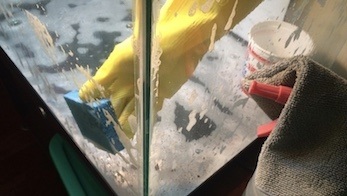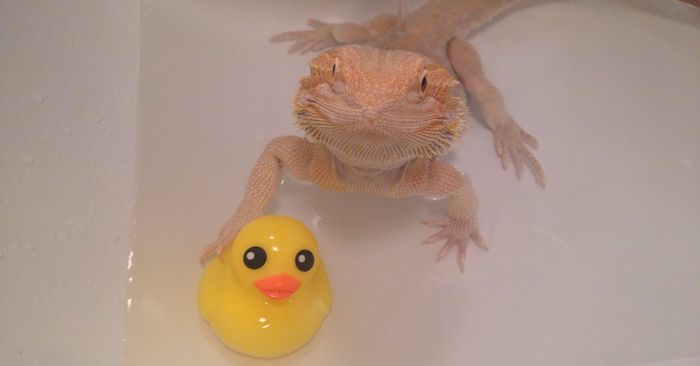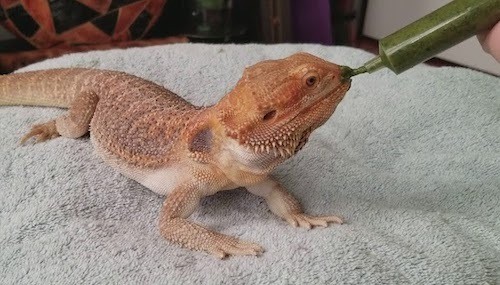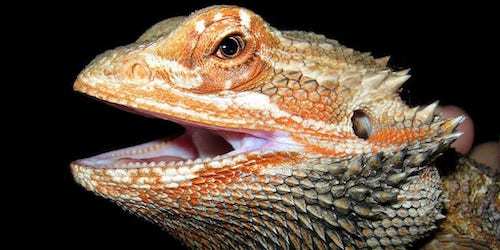Much like other pets, such as the family cat or dog, your bearded dragon can in fact suffer from an Upper Respiratory Infection (URI).
Although quite common amongst beardies, this illness can turn serious and even fatal if left untreated, so it it important that you know the
What is an Upper Respiratory Infection Exactly? A URI is a bacterial infection in the lungs that results from excess moisture.
If left untreated, URIs can prove deadly, which is why it is SO important you know the symptoms associated with them.
In This Article
How to Prevent a Bearded Dragon Upper Respiratory Infection
Regardless of whether your bearded dragon has actually had a RI or not, you’re going to want to abide by the advice below.
Of course, If you suspect your bearded dragon has a RI, get them to the vet ASAP. Otherwise, simply check out my advice below to keep them healthy.
Ensure Humidity Levels Never Exceed 40%

As arid desert dwellers, bearded dragons are used to a dry climate and too much moisture in the air can prove dangerous for their inept lungs.
Humidity levels are something you should ALWAYS be aware of in your pet’s vivarium.
Ideal humidity will fall between 30% and 40%, but NEVER any higher.
This level will best emulate that of their natural climate in Australia.
Verify that the humidity in your dragon’s setup is healthy by investing in a reliable hygrometer.
I’ve always preferred slightly more expensive models because I find them to just be more accurate (not to mention long lasting) in their readings.
(Just as an aside, I personally LOVE this one because it lets me actually keep tabs on my bearded dragon’s cage temperature and humidity levels from my smartphone, as well as track them over time. I can even enable alerts to go off if the levels drop or rise too much! How cool, right?)
Keep Stress to a Minimum
It doesn’t take a genius to know that when we experience regular stress, our immune system is weakened and our overall health can subsequently be compromised. This too is true of bearded dragons.
Whether you’ve just adopted them, moved them into a new tank, or subjected them to any other major life changes, it is important to be cognizant of the potential stress they could be under.
Fortunately, there are things you can do to quickly destress your beardie and keep them healthy!
Regularly Clean & Disinfect the Tank

Because moisture, mold, and other nastiness can build up over time, I highly recommend that you deep clean your bearded dragon’s tank at least once every 3 months, but ideally once a month if you can.
The manner in which you clean and disinfect the tank will ultimately depend on what type of setup you have.
Now, there are definitely right and wrong ways to clean your bearded dragon’s tank, so make sure you’re aware of how to properly clean their setup.
Maintain Adequate Temperatures
In case you weren’t already aware, your bearded dragon will require a cool and hot side of their tank for both basking and, well, cooling off.
You’ll want the hot side to top off anywhere from 95-105 degrees for adults and 100-110 for babies. No more, no less.
These heat levels help to burn off any extra moisture in the air that can raise humidity.
For a cool side, try to achieve a temperature of around 85 degrees.
Bearded Dragon Upper Respiratory Infection Causes
Naturally, if you suspect your bearded dragon has a Respiratory Infection, you’re going to want to figure out how exactly how they got it so you can make proper adjustments to ensure they don’t ever get one again.
Consider the following culprits below that are often responsible for a bearded dragon upper respiratory infection…
Dangerous Temperatures & Humidity Levels
I’ve said it time and time again on this website and I’ll say it again… aside from diet, your BEST bet at giving your bearded dragon a long and happy life is to provide them with proper housing.
This means getting their temperatures correct, managing humidity, including sufficient UVB, and more.
When temperatures drop and humidity rises, your bearded dragon can suffer all kinds of issues, including a RI.
As such, you’re going to want to ensure that you closely monitor the tank’s condition at all times…

As mentioned above, keep humidity levels between 30 and 40%, basking temperatures for babies between 105 and 110 and 95 and 100 for adults. For a cool side, try to aim for temps between 80 and 85.
And as long as your tank doesn’t drop below 65 degrees Fahrenheit at night, you won’t need a secondary heat source.
So, disregard the Ceramic Heat Emitter (CHE) in the diagram above.
Using the Wrong Substrate
Certain substrates, such as mulch or bark, are not only dangerous in the sense that they can lead to impaction, but also because they can retain humidity!
Having the RIGHT substrate is a HUGE component on ensuring your bearded dragon’s tank is on point and fit to keep them happy and healthy.
Fortunately, you can choose from tons of different and safe substrate options to customize a tank your bearded dragon (and wallet!) will equally love.
Poor Bathing Practices

Some owners swear by bathing their bearded dragons several or once a week while others staunchly claim that this is totally unnecessary.
No matter which side of the debate you fall on, one this is for sure…
You need to closely monitor your bath level to ensure it stays lower than your bearded dragon’s vents.
When the water level is too high, dragons can breathe it in and aspirate it in their lungs.
Bearded Dragon Upper Respiratory Infection Symptoms
- Lethargy
- Lack of appetite
- Mouth breathing/gaping mouth
- Black bearding
- Snorting, sniffling, wheezing
- Weight loss
- Difficulty breathing
- Runny discharge from mouth or snout
- Bloated/puffy throat and/or body
- Noises coming from their throat
As you can tell, these symptoms are pretty self explanatory. I’ve gone ahead and bolded the most telling symptoms that likely indicate a RI.
If your bearded dragon is demonstrating any of the bolded symptoms above, I HIGHLY recommend you get them to a vet ASAP.
Bearded Dragon Upper Respiratory Infection Treatment
If you suspect that your bearded dragon is suffering from a URI, then obviously your first step of action should be to get them to the vet ASAP!
If you can’t get them to the vet right away, here’s some suggestions of things you can do to hopefully mitigate (or potentially cure) the infection…
Raise Cage Temperatures Slightly
Your bearded dragon has, at this point, some extra moisture in their lungs that would benefit from being burnt off.
As such, you can raise cage temps by 3-5 degrees to help with this.
Obviously, if your temperatures were WAY off to begin with, you’ll need to raise them more than this.
Normal cage temps should be for adults should be between 95 and 100 on the hot side of the tank and 85 on the cool side.
For babies, aim for the hot side being between 105 and 110.
Give Them a Slurry with Serrapeptase

Essentially a miracle ingredient for helping URIs, Serrapeptase is an enzyme derived from silk worms that thins mucous and prevents/fights bacterial infections in the lungs.
Make the jump and scroll towards the bottom of this article to learn the recipe for this supercharged URI slurry recipe you should be giving them as they fight off the infection.
Elevate Your Beardie to Help Drain Mucous
If you suspect your bearded dragon is very congested, I recommend propping them up on a towel or folded blanket with their face angling downwards so the mucous can drain from their throat.
You don’t want a severe angle, just around 10 to 15 degrees is sufficient.
Use a Dehumidifier
If you are having a hard time keeping the humidity level of the tank under 40%, I highly recommend you incorporate a dehumidifier.
When your bearded dragon is living in an environment where moisture is abundant, I can almost guarantee you that URIs are going to become a common occurrence.
You can always invest in a high tech and expensive dehumidifier if you’re looking to lower humidity levels in an entire room or throughout the home.
For me, I’ve found cost effective alternatives that work fabulously in just my pet’s tank…
I’ve used this dehumidifier for years mounted up high inside my bearded dragon’s tank and it has been such a great way to pull excess moisture out of the tank.
I love that it has no wires and only needs to be “recharged” about once a month.
Treat Them for a Week with a Fogger
https://youtu.be/6v5EkIWW1Xg?t=112
For those unaware, a fogger will transform liquids into vapor that can be inhaled directly into the lungs.
In the case of a bearded dragon URI, a good fogger like this will allow you to treat the lungs directly and efficiently.
And while a fogger is not an alternative to seeking medical attention, it can help buy you time and cure bearded dragons who have very weak URIs that are not fully developed.
However, I still recommend you get your bearded dragon to the vet ASAP, especially in more severe cases.
The secret here lies in the high sterilizing properties of F10sc Veterniary Disinfectant, which in higher doses can kill bacteria, such as that with a URI.
F10sc is also fabulous to have on hand for cleaning the tank, treating Yellow Fungus, and essentially sterilizing anything.
With that being said, here’s how you’ll want to use the fogger/nebulizer to help combat a URI…
Make a solution of 1:250 F10sc Veterinary Disinfectant to water (1ml F10sc per 250ml of water).
I recommend, as does the video above, using 3-4ml of F10sc, which will require 750-1000ml of water.
You’ll also need a large tub to place your reptile in during the fogging, one which you can easily drill a hole for the fogger hose to fit through
Wrapping Up Bearded Dragon Respiratory Infection
So, there you have it. These are the symptoms, causes, and treatments that you, as a responsible bearded dragon owner, should be aware.
After all, the sooner you are able to notice something is wrong, the quicker you will be able to act and give your dragon a fighting chance.
With URIs being super common amongst bearded dragons and even the most responsible and caring of owners having experience with them, it is always better to be well informed so that you can take control of any situation.
Above all else, YOU are your bearded dragon’s best bet at a happy and healthy life.
Read These Articles Yet?
Definitive Guide to Bearded Dragon Health Insurance
How to Tell if Your Bearded Dragon is Sick
Ways to Help a Shedding Bearded Dragon
